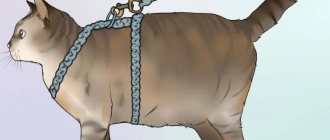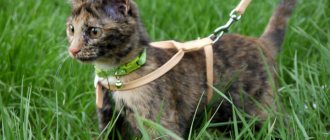Before walking with an animal, a logical question arises: how to quickly put a harness on a domestic cat? Letting your cat walk on its own is the height of irresponsibility. Roads in the city are sprinkled with chemicals, garbage is scattered, and dogs are allowed out without a leash. If frightened, your pet will easily get lost or run away. A purebred cat can easily be stolen or considered lost.
There are several types of leashes for cats. The choice depends on the personal preferences of the owner and his budget. For example, a harness-vest costs more than a regular belt. Types of harnesses:
- "eight";
- V-shaped;
- H-shaped;
- harness-vest.
Below is a photo of how to put any harness on a domestic cat so as not to harm it.
Factors to consider:
- belt width. Narrow belts cut painfully into the body. The optimal width is 1–2 cm;
- strong fastenings. Weak clasps can break or come undone;
- There should be a small space between the body and the straps; it will not allow the cat to escape, but will not restrict movement.
How to put a harness on a cat
It should be noted that this accessory should be comfortable for your pet so as not to cause anxiety or unnecessary excitement.
There are several basic steps that will help you correctly and correctly put a harness on your cat:
- It is necessary to let your pet sniff the harness and get used to it in order to avoid unnecessary anxiety.
- Before starting the process, it is important to pick up your pet and, if he appears anxious, pet him and calm him down.
- Do not make sudden, noisy movements, do everything carefully and calmly.
If these points are followed, the procedure will give the desired result and will not take much time. Next, we will look at various methods for collecting harnesses depending on their type.
Owner reviews
Oh, it's Friday. In general... We looked for a harness for a long time... Then we started putting it on... Something began to happen. This face tore us all apart!! In general, they didn’t dress her... That’s where the party ended... Well, to hell with her. He doesn’t want to go for a walk and there’s no need to!!
gutik
https://forums.zooclub.ru/showthread.php?t=464&page=2
And we put on a leash on the street, when there are already a lot of distractions and the cats don’t notice the leash, it freezes, and here we are, quickly put it on and ran through the bushes.
Mavra
https://forums.zooclub.ru/showthread.php?t=464&page=2
Karlushka
https://forum.mau.ru/viewtopic.php?p=4770204
Calvados
https://forum.mau.ru/viewtopic.php?p=4770204
Katrishka
https://forums.zooclub.ru/showthread.php?t=464&page=2
How to assemble a cat harness
Depending on the configuration, temperament and breed of your pet, there are different variations of harnesses.
The main guiding factor is maximum comfort - it is important that the harness fits your cat and does not rub or squeeze the animal.
There are certain nuances when assembling different types of harnesses.
Eight:
- This accessory consists of parts. One part - a small loop is put on the cat's neck, it should slide over the animal's head, it does not need to be unfastened. The carbine ends up on the animal's back. The front paws are inserted into the second part - a large loop; it should go around the cat's chest. The loops can also be adjusted to make them wider or narrower.
- Next, you should put the smallest of the loops on the animal’s head. The junction of the loop and the connecting strap should be slightly above shoulder level. The middle of the figure eight should lie between the shoulder blades.
- You need to take the ends of the large loop that are located under the animal’s chest and connect them.
- It is important to ensure that none of the loops are twisted and become a source of irritation for your pet.
- It is necessary to check the fit of the belts. There should be 2 fingers between the harness and the animal.
- The leash must be fastened to the ring located in the animal’s back area, after which the harness itself is checked for strength.
Reviews
AsyaJust Asya
https://irecommend.ru/content/vygulivaem-koshku
Lenochek91
https://irecommend.ru/content/deshevo-i-udobno-odevaetsya-foto
Burbuzyaka
https://irecommend.ru/content/khoroshaya-shleika-po-dostupnoi-tsenefoto-gulyayushchego-koteiki
Lyudmilabagira 98
https://otzovik.com/review_3609426.html
ycb1
https://popgun.ru/viewtopic.php?f=113&t=246046
Karlushka
https://forum.mau.ru/viewtopic.php?p=4770204
Calvados
https://forum.mau.ru/viewtopic.php?p=4770204
DarlingS
https://teron.ru/index.php?showtopic=2202006
DIY cat harness
A photo of the V-harness is shown below:
- In order to correctly and competently make a harness for a cat with your own hands, you must initially take measurements of the pet: the circumference of the neck, as well as the chest, the length of the neck from the base of the head to the middle of the chest. The result will be two circles - a large and a small one and a line between them.
- Next we will need A3 paper, a pencil, a ruler and a centimeter. The length of the paper is determined by the size of the animal - it should be the same or slightly longer than the circumference of the cat.
- You also need to add 1 centimeter to the resulting measurements in the drawing to make sure that you have trimmed the fabric enough. This indentation will be the distance between the edge of the fabric and the stitches.
- Then you need to cut out the template and try it on the cat.
- The next step is to prepare the necessary material for making the harness. For this we will need: thick fabric (denim or cotton is recommended, as it is quite dense, soft and durable), lining, thread matching the color of the fabric, scissors, D-ring, protective fabric, sewn-on Velcro.
The protective fabric is used to strengthen the main fabric. It should be the same weight as the other type of fabric or less.
The ring should be wide enough to allow the nylon tape to pass through it freely. The length of the nylon strap itself should correspond to the middle circle of the vest. It is important to note that the thicker the tape, the more difficult it will be to sew.
To make a harness pattern we will need: a sewing machine, scissors, pins, an iron, a tape measure. If you don’t have a sewing machine in your arsenal, you can sew it yourself, but it will take a little more time.
Training and walking rules
The optimal time for getting used to is 5-10 minutes. It is better if the short-term procedure is repeated more than once. Make time for exercise before meals and then feed your pet - then your cat will associate it with something pleasant.
Try to do what the animal wants: run with it, wait, just be close, and soon the pet will get used to it. When the cat is completely comfortable, you can go outside with a leash.
Pattern of a harness for a cat
- It is necessary to cut out the fabric, lining and face protective fabric, then place the harness diagram on top of the cut out and attach with pins. It is important to remember to indent 1cm from the main measurements.
- Let's start sewing all the parts of the pattern. You should start from the wrong side, folding the edges. This is done to ensure that the seams are inside the vest. Next, you should align the edges relative to each other and stitch around the perimeter, then iron everything.
- On the part of the harness that will be located in the animal's back area, you need to sew a D-shaped ring. It should be threaded through the nylon tape with the rounded part facing out.
- Finally, we sew the Velcro to the harness. They should overlap each other; accordingly, we place part of the Velcro on the wrong side of the pattern, the other on the outside.
After the manipulations have been done, you should try on the resulting vest on the cat and check how it sits on it.
First experiments
Experienced owners recommend doing the following: take the cat outside in a carrier bag so that there is an opportunity to explore the environment from a “safe distance.” And only then provide the opportunity to walk on a leash. This is how the owner will be able to study the behavior of his cat outside his usual apartment and accurately determine whether the pet needs regular trips outside.
Having chosen the most suitable area, the pet is carefully lowered to the ground. Don’t be distracted by your phone or conversations with friends, control every step and surroundings, because at any moment a stranger or a dog without a leash may appear. Give the cat the opportunity to satisfy its curiosity, do not pull it away from every bush (such actions can cause injury to the animal).
Make sure that your household does not pick up anything from the ground. Do not let him near the carcasses of small rodents or birds. Avoid contact with other cats, which may provoke aggression. Don't let it go too far.
The first walk should not last longer than 10-15 minutes. Only in the future is it possible to increase the time to 30-40 minutes, when the purr adapts to new conditions. Individuals on their own determine the duration of their travel.
And at the dacha you can without a leash
Photo of harnesses for cats
Why do you need street ammunition?
Many owners of cats, especially those that are not bred, let their pets go for an independent walk in the yard. And outside the home, small predators face dozens of troubles in the form of yard cats guarding their own territory, aggressive dogs and cars. It’s not worth reminding once again about the possibility of infection with parasites (fleas, ticks, lice eaters). In addition, cats are freedom-loving creatures and it is often not so easy to return them home.
A pet on the street faces many other dangers from people. And a trip to the veterinarian or a trip will become a difficult mission if the cat does not want to sit in the carrier. But what to do if you can’t keep a curious freedom lover at home? There is an exit! You can walk your fluffy, controlling his freedom of movement. Fortunately, today the choice of accessories is quite wide.
What does it represent?
Almost every cat needs at least rare walks in the fresh air, which strengthen the immune system, prevent the development of heart and vascular diseases, and also reduce the likelihood of developing obesity. To make walking easier, it is recommended that owners purchase a special harness from a pet store, which comes in several types. It is especially important to think about purchasing a collar for residents of large cities, where a cat can easily get lost. In the store you can purchase a harness for kittens and adults, but you need to follow a special sequence of actions in order to attach it correctly. Such a cat accessory has a number of advantages:
- convenient design;
- reliability of fixation;
- minimal risk of choking when the leash is pulled tightly;
- It is delicate and does not injure the cat’s fur and skin.
Veterinarians note that it is better to purchase a harness for walking cats rather than a collar. This is due to the fact that in the latter case the load on the pet’s neck muscles increases, which can lead to some pathologies.
Such products are manufactured under the Trixie brand.
There are different manufacturers that make cat harnesses, but the most popular are:
- Trixie;
- Dezzie;
- Papillon;
- Yami-Yami.
Dimensional features
Just like with human clothing, you need to choose the appropriate harness size. This ensures that it sits comfortably, evenly, in the places specified for the design.
How to choose the size of a harness for a kitten
The size is usually indicated directly on the packaging. Approximate parameters correspond to the size of a cat at a certain age and body weight.
The following markings exist:
- S (small) – for kittens, small breeds.
- M (medium) – medium size.
- L (large) – for large and very large breeds.
Before purchasing, measure your pet's girth under the front legs and the length of the back from the shoulder blades to the tail. Most harnesses are adjustable with belts, so add 5-7 cm (1-2 fingers to the body) to the result, “for growth.” Check your results with the harness packaging and buy the exact size.
In addition to the length of the straps, it is important to check the width. The larger the pet, the wider the straps it needs. Otherwise, the structure will dig into the body uncomfortably. On average it is 1 – 1.5 centimeters.











